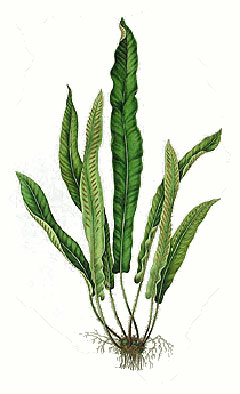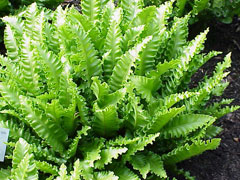 |
|
http://commons.wikimedia.org/wiki/User:Abalg |
 |
| http://commons.wikimedia.org/wiki/File:Phyllitis_scolopendrium3.jpg |
Translate this page:
Summary
Physical Characteristics

 Asplenium scolopendrium is an evergreen Fern growing to 0.6 m (2ft) by 0.5 m (1ft 8in) at a slow rate.
Asplenium scolopendrium is an evergreen Fern growing to 0.6 m (2ft) by 0.5 m (1ft 8in) at a slow rate.
See above for USDA hardiness. It is hardy to UK zone 5 and is not frost tender. It is in leaf all year, and the seeds ripen from July to August.
Suitable for: light (sandy) and medium (loamy) soils and can grow in heavy clay soil. Suitable pH: mildly acid, neutral and basic (mildly alkaline) soils and can grow in very alkaline soils.
It can grow in full shade (deep woodland) or semi-shade (light woodland). It prefers dry or moist soil.
UK Hardiness Map
US Hardiness Map
Synonyms
Phyllitis scolopendrium. (L.)Newman. Scolopendrium officinale. S. vulgaris.
Plant Habitats
Woodland Garden Dappled Shade; Shady Edge; Ground Cover; North Wall. In. East Wall. In. West Wall. In.
Edible Uses
References More on Edible Uses
Medicinal Uses
Plants For A Future can not take any responsibility for any adverse effects from the use of plants. Always seek advice from a professional before using a plant medicinally.
Astringent Cholagogue Diaphoretic Diuretic Dysentery Expectorant Vulnerary
The fronds are astringent, cholagogue, diaphoretic, diuretic, expectorant, vulnerary[4, 7, 9, 165]. Externally it is used as an ointment in the treatment of piles, burns and scalds[4]. An infusion is taken internally for the treatment of diarrhoea, dysentery, gravelly deposits of the bladder and for removing obstructions of the liver and spleen[4]. The fronds are harvested during the summer and can be dried for later use[7].
References More on Medicinal Uses
The Bookshop: Edible Plant Books
Our Latest books on Perennial Plants For Food Forests and Permaculture Gardens in paperback or digital formats.

Edible Tropical Plants
Food Forest Plants for Hotter Conditions: 250+ Plants For Tropical Food Forests & Permaculture Gardens.
More

Edible Temperate Plants
Plants for Your Food Forest: 500 Plants for Temperate Food Forests & Permaculture Gardens.
More

More Books
PFAF have eight books available in paperback and digital formats. Browse the shop for more information.
Shop Now
Other Uses
Cosmetic
A good ground cover plant for shady positions[28, 200], so long as it is planted no more than 30cm apart each way[208]. Plants form a slowly spreading clump[208]. A decoction of the fronds is used cosmetically as a hair wash to counteract greasy skin and also as a face pack for delicate skin[7].
Special Uses
Ground cover
References More on Other Uses
Cultivation details
Easily grown in a shady position in a soil that is rich in leaf-mould[187]. Prefers a light sandy soil[1]. Succeeds on chalk[28]. Plants can be grown on drystone walls[219]. Grows well in heavy clay soils. Prefers a shady position with no more than 3 hours sunlight a day, greater exposure will cause yellowing and burning of the leaves[187]. One report says that it succeeds in dry shade[188]. Requires a pH of 6 or more in order to flourish. Plants are hardy to about -30°c[187], they grow very well in SW. England[31]. A very adaptable plant[28]. There are many named forms, selected for their ornamental value[187, 200]. Members of this genus are rarely if ever troubled by browsing deer[233].
References Carbon Farming Information and Carbon Sequestration Information
Temperature Converter
Type a value in the Celsius field to convert the value to Fahrenheit:
Fahrenheit:
The PFAF Bookshop
Plants For A Future have a number of books available in paperback and digital form. Book titles include Edible Plants, Edible Perennials, Edible Trees,Edible Shrubs, Woodland Gardening, and Temperate Food Forest Plants. Our new book is Food Forest Plants For Hotter Conditions (Tropical and Sub-Tropical).
Shop Now
Plant Propagation
Spores - best sown as soon as they are ripe on the surface of a humus-rich sterilized soil. Keep the compost moist, preferably by putting a plastic bag over the pot. The spores usually germinate in the spring[1]. Spring sown spores germinate in 1 - 3 months at 15°c[134]. Pot on small clumps of plantlets as soon as they are large enough to handle and grow them on in light shade in a greenhouse. Keep the plants humid until they are well established. Once the plants are 15cm or more tall, plant them out into their permanent positions in the spring. Division in spring. Leaf bases - dig up the plant and wash off the soil until the old caudex covered with 'dead' leaf bases can be clearly seen. Strip off these bases individually by peeling them down the caudex. At the point of attachment they will be green. Young plants can be raised by planting these leaf bases, green tip up, in a pot of loam-based compost and enclosing the pot in a plastic bag. Within one month green swellings will appear around the original point of attachment to the caudex, each of these will develop quite quickly into a young fern. It takes 3 months in summer but longer in winter[200].
Other Names
If available other names are mentioned here
Native Range
TEMPERATE ASIA: Israel, Jordan, Lebanon, Syria, Turkey, Russian Federation-Ciscaucasia (Ciscaucasia), Armenia, Azerbaijan, Georgia, Russian Federation (Dagestan), Russian Federation (Kurile Islands (south)), China, Korea, Japan (Hokkaidô, Honshu, Kyushu, Shikoku) NORTHERN AMERICA: Canada (Ontario), United States (Michigan, New York, Alabama, Tennessee), Mexico (Nuevo León) EUROPE: Denmark, United Kingdom, Ireland, Norway, Sweden, Austria, Belgium, Switzerland, Czech Republic, Germany, Hungary, Netherlands, Poland, Slovakia, Estonia, Moldova, Ukraine (incl. Krym), Albania, Bulgaria, Greece, Croatia, Italy, North Macedonia, Montenegro, Romania, Serbia, Slovenia, Spain, France, Portugal AFRICA: Spain (Canarias), Algeria, Libya, Morocco, Tunisia
Weed Potential
Right plant wrong place. We are currently updating this section.
Please note that a plant may be invasive in one area but may not in your area so it's worth checking.
Conservation Status
IUCN Red List of Threatened Plants Status :

| Related Plants
|
| Latin Name | Common Name | Habit | Height | Hardiness | Growth | Soil | Shade | Moisture | Edible | Medicinal | Other |
| Asplenium adiantum-nigrum | Black Spleenwort | Fern | 0.5 |
5-9
| | LM | FS | M | 0 | 2 | 2 |
| Asplenium bulbiferum | Hen And Chicken Fern, Parsley Fern, Mother Spleenwort | Fern | 0.3 |
10-11
| S | LMH | SN | M | 1 | 0 | |
| Asplenium ceterach | Scale Fern | Fern | 0.2 |
7-10
| M | LM | FSN | M | 0 | 2 | 2 |
| Asplenium ruta-muraria | Wall Rue, Lance asplenium | Fern | 0.1 |
5-9
| S | LM | S | M | 0 | 2 | |
| Asplenium trichomanes | Maidenhair Spleenwort, Dense spleenwort, Toothed spleenwort, Brightgreen spleenwort | Fern | 0.4 |
5-9
| M | LM | FS | M | 1 | 1 | 2 |
| Athyrium filix-femina | Lady Fern, Common ladyfern, Subarctic ladyfern, Asplenium ladyfern, Southern Lady Fern, Tatting Fer | Fern | 0.6 |
3-8
| M | LMH | FS | M | 1 | 2 | 2 |
|
Growth: S = slow M = medium F = fast. Soil: L = light (sandy) M = medium H = heavy (clay). pH: A = acid N = neutral B = basic (alkaline). Shade: F = full shade S = semi-shade N = no shade. Moisture: D = dry M = Moist We = wet Wa = water.
Now available:
Food Forest Plants for Mediterranean Conditions
350+ Perennial Plants For Mediterranean and Drier Food Forests and Permaculture Gardens.
[Paperback and eBook]
This is the third in Plants For A Future's series of plant guides for food forests tailored to
specific climate zones. Following volumes on temperate and tropical ecosystems, this book focuses
on species suited to Mediterranean conditions—regions with hot, dry summers and cool, wet winters,
often facing the added challenge of climate change.
Read More
Expert comment
Author
L.
Botanical References
17200
Links / References
For a list of references used on this page please go here
Readers comment
© 2010, Plants For A Future. Plants For A Future is a charitable company limited by guarantee, registered in England and Wales. Charity No. 1057719, Company No. 3204567.